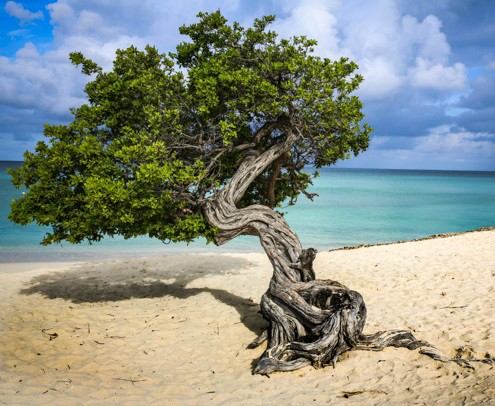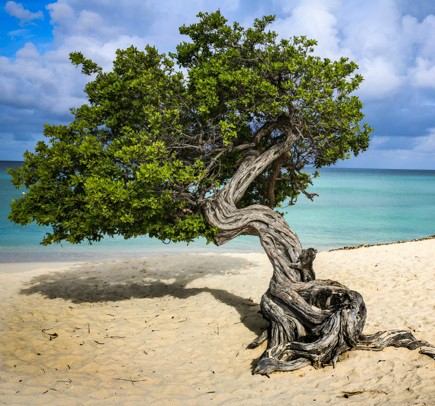Hidden Gems
Hidden Gems of Aruba: Eco-Adventures and Distinct Cuisine
 Every year, about a million and a half people come to visit Aruba. How do they get there? A lot of them come by cruise ship. They come piling off the ship and where do they go? About 10 blocks away from the ship. They buy a hat, a bag, a T-shirt, and they come back to the ship.
Every year, about a million and a half people come to visit Aruba. How do they get there? A lot of them come by cruise ship. They come piling off the ship and where do they go? About 10 blocks away from the ship. They buy a hat, a bag, a T-shirt, and they come back to the ship.
The rest come in by air, and where do they go? To the beach resorts. What do they do there? They never leave the resort. They’re missing out on a lot. So let me share with you my hidden gems of Aruba.
When visitors come to Aruba, they eat at trendy restaurants, kite surf, snorkel, sip tequila sunrises at sunset, that sort of thing. What’s wrong with that? After all, this is the Caribbean.
But then again, when you take the trouble to leave those beaches and explore Aruba, you’ll discover this is actually a Caribbean island like no other. Why? Well, first of all, it’s Dutch influenced. It’s easy to forget the Dutch were a major colonial power until you remember that New York was once called New Amsterdam.
Also, look at a map of the Caribbean. Because it’s so far south, Aruba is more about cactus than coconut palms.
Arikok National Park
The interior of this island is actually an arid desert criss-crossed by a labyrinth of trails made for exploring. Since Aruba is only 20 miles from end to end, all you have to do is hop aboard a 4×4 to become one with nature at Arikok National Park.
The National Park takes up about 18 percent of the entire country. Once you get up to the top of Arikok, what do you find? A desert landscape complete with cacti—and your own private beaches.
The park is home to a group of three caves full of ancient Arawak Indian rock drawing. It’s also home to roughly five hundred bats. So make sure you visit during the day, when all of the bats are sleeping.
Another spot you can’t miss is the park’s natural pool. Just one word of warning: The trip down to the pool, and the trip back from the pool are not on roads, they’re on rocks. Protected from the rough sea by surrounding rocks, this peaceful pool is a great place to swim, snorkel, or just relax. It may be a rough ride, but a trip to Arikok National Park will show you a side of Aruba not everyone sees.
Eco-Friendly Sustainability
 Aruba isn’t just conserving nature—it’s also harnessing it. The Trade Winds, which make this climate so perfect, are also an energy source. The Van der Piet Wind Farm now provides 20 percent of the country’s energy. It’s also become an unofficial tourist attraction.
Aruba isn’t just conserving nature—it’s also harnessing it. The Trade Winds, which make this climate so perfect, are also an energy source. The Van der Piet Wind Farm now provides 20 percent of the country’s energy. It’s also become an unofficial tourist attraction.
Now, we hear a lot about sustainability. Is it an overused term? Aruban Prime Minister Mike Eman says: “For us it is reducing everything with utilizing crude oil products and focusing more on wind and sun energy. We already have 20 percent of total capacity based on the windmill farm we have. By 2020 we’re going for 100 percent total sustainability.”
The Aruban government is also trying to reduce traffic congestion and pollution by creating more walkable neighborhoods. Even basic transportation has received a green makeover.
Take the solar-powered tram in the capital city of Oranjestad—the first of its kind in the Caribbean. Aruba had some rail transportation about 100 years ago, but this new light train fits with the concept of sustainable development for Aruba.
The tram is just part of the plan to transform Aruba into one of the most sustainable countries in the world. The island nation is also creating new green spaces for both locals and visitors to enjoy—because there’s nothing like pedal power for reducing those carbon emissions.
One of the coolest things about Aruba is something called Linear Park–the longest bike trails in the Caribbean. It starts at the airport and by the time it’s finished it’ll span the entire length of the island. Now the really cool thing about it is when you get off the beaten path, it’s right to the beach…and lunch!
Local Cuisine
If you want to really know a country, you need to swear off the resort buffet and try local dishes. Aruban food has flavors unlike anything you’ll find in the rest of the Caribbean.
One place where you can try them is at the old Cunucu House, where they serve up family recipes that go back generations.
The secret to staying true to this Dutch, Spanish, French, and English-influenced cuisine? It’s not about the sauce they put on the dish: it’s about the way they source the ingredients.
That’s why Chef Cretzberg doesn’t start his day in the kitchen, but rather ends up there after spending a morning with local farmers conspiring to create whole new flavors.
To learn more about the island nation of Aruba, check out this clip from season two of The Travel Detective.
Want to learn more about Aruba? Check out:
- Giving Back: How You Can Volunteer at Donkey Sanctuary Aruba
- Aruba: One of the Best Places to Visit Using Your Tax Refund
- Ask the Local Island Guide: Aruba
By Peter Greenberg for PeterGreenberg.com








